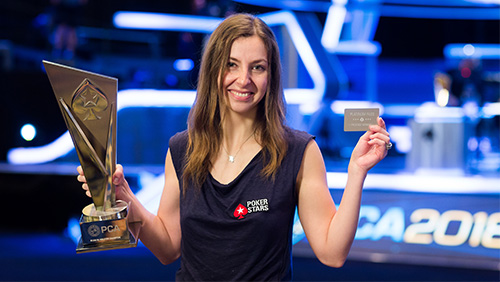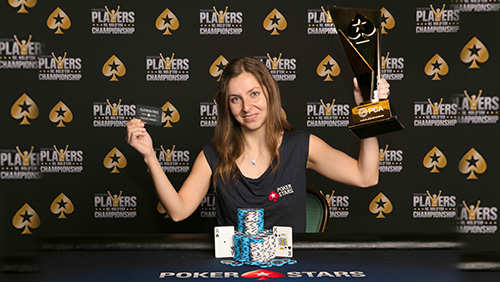Lee Davy sits down with Friend of PokerStars and New York Times best-selling author, Maria Konnikova, to talk about her PCA win, her relationship with Erik Seidel and her new book project.
As I watched Maria Konnikova prepare for her final table appearance in the $1,650 PCA National Final Table she looked like a little sail tre mbling upon the horizon ready to be blown away. Harrison Gimbel and Chris Moorman preparing to provide the monsoon.
mbling upon the horizon ready to be blown away. Harrison Gimbel and Chris Moorman preparing to provide the monsoon.
Stage fright.
Adele sees live performance as a form of torture, and yet when she opens her mouth, we see lyrical movements of the soul.
And so it was the same with Konnikova.
She got her head down.
Focus.
Victory.
Incredible, when you consider not that long ago, Konnikova had no idea what poker was, and only learned about it when deciding to write, what she hopes will be, her third New York Times Bestseller.
“I had no idea what poker was other than some card game featured in some movies,” Konnikova tells me when I ask her why she chose our beautiful game as the topic of her next book. “I wanted to write about skill versus chance and the role that luck plays in our life, and whether we could learn to tell the difference between the two. Can you learn what you can or can’t control, and can you make the most of what you do control while minimising the bad side of chance and maximising your upswing while recognising those opportunities? That’s not a book; it’s a philosophical query.
“I was reading about chance and read John von Neumann’s Theory of Games because game theory is one approach to looking at skill v chance. I learned from the book that game theory – which is one of the most important mathematical theories of the 20th Century came from poker. He was an awful poker player who loved the game. He thought if he could solve it and figure out a way to reduce poker to these matrices associated with game theory that he would find a way to solve the most complex strategic decisions that humans have to make.
“As he put it, poker isn’t just about information it’s about bluffing people, all of these very complex interactions between individuals. If you can figure out how to model this, you can figure out how to prevent nuclear war (he writes that poker might be a key to that). This intrigued me because this guy is a genius and if he thinks poker is important, then there may be something to it.
“So, I started reading about poker. And it was an aha moment when I realised this could be a narrative for the book. As I knew nothing about poker, how about I went from zero to playing professionally, immersing myself, learning the ins and outs, and have that journey form the narrative frame with the end goal of trying to understand the role of skill v chance through poker, which turns out to be the perfect laboratory for testing. And then at the end of the day to emerge from it as a person who is capable of making better decisions; knows more about myself; about life and is capable of tackling some of these bigger questions after going through the life learning lab of poker.”
I read in a previous interview with Konnikova that she feels like every table in a poker game is a microcosm of life. I wanted to hear more.
“There’s a moment when you embark on any book project where you’re nervous,” says Konnikova. “You will be living with this for years, and you have to love it, and it has to work. I didn’t sell the book until after I had started working with Erik {Seidel} because I had to make sure it would work as a project. It was the most gratifying feeling in the world to realise that poker is an even better metaphor for life than I thought it would be.
“It was one of these things where it’s quite the opposite of what you fear. It’s this amazing feeling to discover, that it’s much better than I ever thought, it will teach me so much, and I love it. I find the game so challenging. Poker is such a great decision-making tool, much better than chess because chess is a game of complete information and life is not like that because there are shades of grey like there are in poker. I went from one extreme to not knowing how many cards there are in a deck to the other end where I think everyone should play poker.”
To prove that poker is a microcosm of life, consider how Konnikova won the PCA National event, $84,600, and a $30k Platinum Pass for the $25,000 PokerStars Player’s No-Limit Hold’em Championship. Her backroom staff included Erik Seidel, Phil Galfond and the full weight of PokerStars.
It’s proof personified that great mentors are only an email away.
“I have gotten very, very lucky,” laughs Konnikova. “In the case of Erik and Phil and Eric Hollreiser who signed me onto PokerStars – they could tell how passionate I was about the project and how much I have become a person who wants to spread the love of poker around the world.
“It helps that Erik and I get along very well and seem to be on the same wavelength when it comes to how we think through different decisions when we discuss poker and various elements of the game. It’s been helpful enjoying time together.
“Erik introduced me to Phil, and he was on board from the beginning. They are both very nice people. I was doing well, clearly learning from them, taking their lessons to heart, really wanting to learn encouraged them to want to share more with me. With PokerStars, it’s lucky they saw the value in this project and were willing to believe in me and that this would be good for the poker world, and invest in me without zero return in the beginning. Everyone took a leap of faith with me, and I hope I don’t let them all down.”
I’ve just finished reading Breaking The Habit of Being Yourself by Joe Dispenza where he talks about the power of the quantum field and how we can have anything we want in life; we just have to want it. I have a vision of Konnikova waking up in the morning and meditating on winning millions of dollars. On the wall at the end of her bed is a vision board with photographs of Seidel, Galfond and PokerStars aside fake $1m notes.
It’s too good to be true.
“The fact that Erik signed onto the project made it all possible,” Konnikova tells me. “I couldn’t sell the book if I did this on my own. I wouldn’t know where to start. Having him on board and having him be willing to work with me and put his faith in me to see if we could make a go of it. It was an important moment that made everything else possible. He has introduced me to some of the best minds in poker who are willing to talk to me because they like Erik. He introduced me to PokerStars. I didn’t even know they existed; I didn’t know online poker was a thing.
“He opened this world to me, not just by teaching me, but by being willing to make these connections with people. I am working incredibly hard and will work incredibly hard to keep growing and learning but let’s not underestimate the resources I have available to me. Not many people get to discuss hands with Erik Seidel while Phil Galfond is analysing your online game to ensure you don’t have any leaks.”
I push Konnikova harder.
Every gas fitter, dog walker and electrician who loves poker craves the attention of the world’s best players. To climb underneath a wing of a star like Seidel or Galfond is dreamlike. I can’t get Seidel to sit down and talk to me for ten minutes. He doesn’t want the media attention. He’s happy to play poker and head back to his room when it’s over. So how did she convince him to give his time to this project?
“We had never met before,” Konnikova confirms. “I contacted him out of the blue. I’m a journalist, so I don’t mind reaching out to people who are high profile and are great at what they do. I just told him I was working on a new book project and I would like to talk to him about it. I didn’t give him a hint of what it was about. I felt it would be better over the phone. At this time I didn’t know he spent a lot of his time in New York. Otherwise, I would have asked to meet him. He wrote back and said, “I love the New Yorker, this seems interesting let’s meet for coffee I am in New York.”
“We got together for coffee, I pitched my idea, I told him about my psychology background, I told him I knew nothing about poker, gave him my plans for the project, and he said it could be really interesting and good for poker. Erik is so passionate about poker. He truly enjoys it. His worse nightmare would be retiring, And he wants to bring people to poker, especially women. He has two daughters. He is a huge feminist and has been supporting me like a father figure to make sure nobody messes with me. I was coming at this from such a different angle. For him, it’s a philosophical test. So many people say his approach is outdated. His results say otherwise. And he incorporates new elements into his strategies all the time as he learns from what he calls the young wizards.
“Obviously, I’m not going to become a GTO wizard in a year. The question is, with hard work and my background will my approach work? It’s not like he agreed to work with me indefinitely straight away. He wanted a trial to see if I had the aptitude or talent for this. No matter how much hard work I did, it wouldn’t matter if I couldn’t play poker.
“I also think it helps me that I have had some amazing mentors in my life. I appreciate it. I know what a big commitment it is. I have mentored younger writers. I try not to impose on their time; be respectful, but get what I need. Doing your research helps. I had no idea Erik had never taken students before, that would have deterred me a bit.”
 Every time I read a piece about Konnikova I see the words, “work my arse off.” With so many training tools at her disposal, and so many top people talking poker with her, I wonder what single tool has served her the most throughout her training?
Every time I read a piece about Konnikova I see the words, “work my arse off.” With so many training tools at her disposal, and so many top people talking poker with her, I wonder what single tool has served her the most throughout her training?
“Talking through hands with Erik,” Konnikova replies without thinking. “Him teaching me how to look at a hand, how to look at a table. He would yell at me, not literally, for not talking about the hand in the right way, not giving him the correct information, not phrasing things in the right way. He is very strict with me which is wonderful because it forces me to develop good habits. I am never allowed to talk about bad beats. If I start talking about bad beats, he cuts me off right away and says, “Wait do you have a question about this hand or I don’t want to know”. I think it’s great because it means I don’t dwell on a lot of stuff.
“We will also watch an SHRB video on PokerGO and pause it and go through some of the hands. This is also helpful for him because he plays against these players, and I am learning, figuring out how the best players in the world work.
“In terms of online resources, RunItOnce has been out of this world good. There are so many coaches. You can figure out many aspects of your game. When I wanted to learn deep stack MTT play; short-stack play. You can find the best players in the world talking about their game, and it’s very useful.”
The book project already has a brilliant ending. But it could be so much better. Konnikova’s victory means she will compete in the $25k at the end of the year, and her mentor Erik Seidel will also be in that field. Does her interest in that event change the way she will approach her training regime?
“I’m ramping up my training after the PCA win,” confirms Konnikova. “It’s proof of concept. It’s working. I can do this. Working my arse off has paid off, so we are ramping up to work my arse off times twenty. I am planning on upping my live play schedule, intensifying my training. What I’m doing doesn’t change, but the intensity and application changes. My drive has changed, my goals have changed, the stakes have changed. I don’t want this to be a one-time thing. I want to ensure this isn’t a fluke. I want to show that I am someone capable of playing at this level. Am I going to start playing $25k events, regularly, no. You need to know your level of competence.”
Konnikova may have fallen into poker like a stray coathanger falls to the wardrobe floor, but remarkably, she just might come out of this as a semi-professional poker player.
“I think if my results continue to be good I can combine the two,” says Konnikova. “There’s no reason why you can’t write and play poker. It brings me to new areas and new people who I can write about. I am motivated. I can see a world where I do both. As a pro writer, I am successful and can make a living out of writing. I don’t make that much money. Unless you are insanely successful, you have a capped earnings because writing is not a lucrative career, that’s not why you do it. But if I could get consistent poker results then that would be a great way to make additional income with a game I have grown to love. It could be emotionally and intellectually stimulating. I love the game and think it’s fun, but I know it’s making me grow as a person.”
And how does poker make her feel?
“It makes me feel challenged; happy; when I’m playing I feel like I am accomplishing something,” says Konnikova. “It makes me feel like I am growing as a person, emotionally, intellectually. I am learning about myself. Sometimes it’s frustrating, nerve-wracking, sometimes I feel like I’m about to throw up before a tournament because I am nervous, but ultimately to get through that is a very satisfying feeling.”





